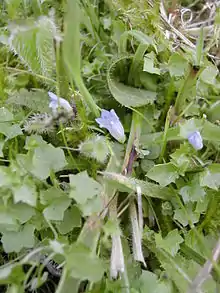Hesperocodon
Hesperocodon hederaceus, synonym Wahlenbergia hederacea, also known as the ivy-leaved bellflower,[1] is a species of flowering plant that is found throughout Europe. It is the only species in the genus Hesperocodon. The delicate, patch-forming, hairless perennial herb has thin, creeping stems about 20 cm in length. Its pale green leaves are long-stalked and have an ivy-shaped, rounded structure. These leaves can be described as having a cordate shape and are approximately 5–12 mm long and wide. The plant has erect, solitary, pale blue flowers in summer and autumn,[2] with bell-shaped corolla with 5 short lobes.[3] The flowers are 6–10 mm long x 5–8 mm wide[4] and sit on fine stalks 1–4 cm long. It is suggested that the long pedicels are an adaptation to assist in seed dispersal.[5]
| Hesperocodon | |
|---|---|
 | |
| Scientific classification | |
| Kingdom: | Plantae |
| Clade: | Tracheophytes |
| Clade: | Angiosperms |
| Clade: | Eudicots |
| Clade: | Asterids |
| Order: | Asterales |
| Family: | Campanulaceae |
| Genus: | Hesperocodon Eddie & Cupido |
| Species: | H. hederaceus |
| Binomial name | |
| Hesperocodon hederaceus (L.) Eddie & Cupido | |
| Synonyms | |
| |
Habitat
Hesperocodon hederaceus is found in cool, moist and boggy, partially-shaded areas,[3] typically with acidic soils, such as woodlands, streams, pastures, heaths and beside rivulets. The plant thrives in short-grassed areas beside streams, with moist, acidic soils, and is almost never found in basic soils and stagnant water.[6] They usually occur in small, scattered groups. The abundance of the ivy-leaved bellflower has been declining throughout the 1900s due to the loss of their habitat.[5]
Distribution
Hesperocodon hederaceus is native to Europe and commonly found in Southern England, and Wales,[7] but also in North West England, Western Scotland, Ireland, France, Belgium, Netherlands, Luxembourg, Western Germany, Spain, and Portugal.[6]
Gallery
References
- BSBI List 2007 (xls). Botanical Society of Britain and Ireland. Archived from the original (xls) on 2015-06-26. Retrieved 2014-10-17.
- Robinson, William (2009). Hardy Flowers. Applewood Books. p. 261. ISBN 9781429014434.
- Everett, Thomas H. (1982). The New York Botanical Garden illustrated encyclopedia of horticulture. Vol. 10. New York Botanical Garden. New York: Taylor & Francis. pp. 3521. ISBN 9780824072407.
- The Wild Flower Key, British Isles N.W. Europe, Francis Rose, WARNE, Published by the Penguin Group, 1991 reissue, ISBN 0-7232-2419-6
- Eddie, William; Cupido, Christopher (March 2014). "Hesperocodon, a new generic name for Wahlenbergia hederacea (Campanulaceae): phylogeny and capsule dehiscence". Edinburgh Journal of Botany. 71 (1): 63–74. doi:10.1017/s0960428613000310.
- Rix, Martyn (26 February 2004). "Plate 488. Wahlenbergia hederacea". Curtis's Botanical Magazine. 21 (1): 61–64. doi:10.1111/j.1467-8748.2004.00413.x.
- "Wahlenbergia hederacea | Online Atlas of the British and Irish Flora". www.brc.ac.uk.
External links
- "British Wild Plant: Wahlenbergia hederacea Ivy-leaved Bellflower". ukwildflowers.com. Retrieved 2014-08-06.
- Guy Colling (7 April 2011). "Red List of the Vascular Plants of Luxembourg" (PDF). Ferrantia: Musée National d'Histoire Naturelle de Luxembourg. ISSN 1682-5519. Retrieved 2014-08-06.
- "Wahlenbergia hederacea | Online Atlas of the British and Irish Flora". brc.ac.uk. Retrieved 2014-08-06.

.jpg.webp)
